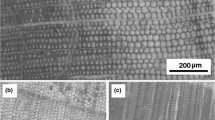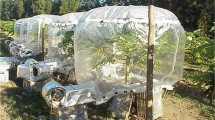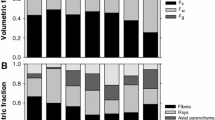Summary
During the Hartheim Experiment (HartX) 1992 conducted in the upper Rhine Valley, Germany, three different methods were used to measure sap flow in Scots pine trees via heating of water transported in the xylem: (1) constant heating applied radially in the sapwood (“Granier-system”-G), (2) constant heating of a stem segment (“Čermák-system”-C), and (3) regulated variable heating of a stem segment that locally maintains a constant temperature gradient in the trunk (“Čermák/Schulze-system”-CS). While the constant heating methods utilize changes in the induced temperature gradient to quantify sap flux, the CS-system estimates water flow from the variable power requirement to maintain a 2 or 3 degree Kelvin temperature gradient over a short distance between inserted electrodes and reference point. The C- and CS-systems assume that all transported water is encompassed and equally heated by the electrodes. In this case, flux rate is determined from temperature difference or energy input and the heat capacity of water. Active sapwood area need not be determined exactly. In contrast, the G-system requires an empirical calibration of the sensors that allows conversion of temperature difference into sap flow density. Estimates of sapwood area are used to calculate the total flux. All three methods assume that the natural fluctuation in temperature of the trunk near the point of insertion of heating and sensing elements is the same as that where reference thermocouples are inserted.
Using all three systems, 24 trees were simultaneously monitored during the HartX campaign. Tree size within the stand ranged between 18 and 61 cm circumference at breast height, while sample trees ranged between 24 and 55 cm circumference. The smallest trees could only be measured by utilizing the G-system. Sap flow rates of individual trees measured at breast height increased rapidly in the morning along with increases in irradiance and vapor pressure deficit (D), decreased slowly during the course of the afternoon with continued increase inD, and decreased more slowly during the night.
Ignoring potential effects introduced by the different methods, maximum flow rates of individual trees ranged between 0.5 and 2.5 kg H2O h−1 tree−1 or 0.3 and 0.6 mm h−1 related to projected crown area of trees and daily sums of sap flow for individual trees varied between 4.4 and 24 kg H2O tree−1 d−1 or 1.1 and 6.0 mm d−1. Maximum sap flow rates per sapwood area of trees varied least for the G-system (11–17 g cm−2 h−1) and was of similar magnitude as the C- (8–21 g cm−2 h−1) and CS-system (4–14 g cm−2 h−1).
Regressions of total tree conductance (g t ) derived from sap flow estimates demonstrated the same linear increase of conductance with increasing irradiance, however decrease of conductance with increasingD under non-limiting light conditions was different for the three systems with strongest reduction ofg t measured with the CS-system followed by the C- and G-system. This led to different estimates of daily sap flow rates especially during the second part of the measurement period.
Variation in sap flow rates is explained on the basis of variation in leaf area index of individual trees, heterogeneity in soil conditions, and methodological differences in sap flow measurements. Despite the highly uniform plantation forest at the scale of hectares, the heterogeneity in tree size and soil depth at the scale of square meters still make it difficult to appropriately and efficiently select sample trees and to scale-up water flux from individual trees to the stand level.
Similar content being viewed by others
References
Čermák, J., Deml, M., Penka, M., 1973: A new method of sap flow determination in trees.Biol. Plant. 15, 171–178.
Čermák, J., Kučera, J., 1981: The compensation of natural temperature gradient at the measuring point during the sap flow rate determination in trees.Biol. Plant. 23, 469–471.
Gay, L. W., Vogt, R., Bernhofer, C., Blanford, J. H., 1996: Flux agreement above a Scots pine plantation.Theor. Appl. Climatol. 53, 33–48.
Granier, A., 1985: Une nouvelle méthode pour la mesure du flux de sève brute dans le tronc des arbres.Ann. Sci. For. 42, 193–200.
Granier, A., 1987: Evaluation of transpiration in a Douglasfir stand by means of sap flow measurements.Tree Physiol. 3, 309–320.
Granier, A., Bobay, V., Gash, J. H. C., Gelpe, J., Saugier, B., Shuttleworth, W. J., 1993: Vapour flux density and transpirations rate comparisons in a stand of Maritime pine (Pinus pinaster Ait.) in Les Landes forest.Agric. Forest. Meteor. 51, 309–319.
Granier, A., Biron, P., Köstner, B., Gay, L. W., Najjar, G., 1996: Comparisons of xylem sap flow and water vapour flux at the stand level and derivation of canopy conductance for Scots pine.Theor. Appl. Climatol. 53, 115–122.
Hollinger, D. Y., Kelliher, F. M., Schulze, E.-D., Köstner, B. M. M., 1994: Coupling of tree transpiration to atmospheric turbulence.Nature 371, 60–62.
Jaeger, L., Kessler, A., 1996: The HARTX period May 1992 seen against the background of twenty years of energy balance climatology at the Hartheim pine forest.Theor. Appl. Climatol. 53, 9–21.
Kelliher, F. M., Köstner, B. M. M., Hollinger, D. Y., Byers, J. N., Hunt, J. E., McSeveny, T. M., Meserth, R., Weir, P. L., Schulze, E.-D., 1992: Evaporation, xylem sap flow, and tree transpiration in a New Zealand broad-leaved forest.Agric. Forest. Meteor. 62, 53–73.
Köstner, B. M. M., Schulze, E.-D., Kelliher, F. M., Hollinger, D. Y., Byers, J. N., Hunt, J. E., McSeveny, T. M., Meserth, R., Weir, P. L., 1992: Transpiration and canopy conductance in a pristine broad-leaved forest ofNothofagus: an analysis of xylem sap flow and eddy correlation measurements.Oecologia 91, 350–359.
Kučera, J., Čermák, J., Penka, M., 1977: Improved thermal method of continual recording the transpiration flow rate dynamics.Biol. Plant. 19, 413–420.
Sturm, N., Reber, S., Kessler, A., Tenhunen, J. D., 1996: Soil moisture variation and plant water stress at the Hartheim Scots pine plantation.Theor. Appl. Climatol. 53, 123–133.
Thom, A. S., 1972: Momentum, mass, and heat exchange of vegetation.Quart. J. Roy. Meteor. Soc. 98, 124–134.
Waring, R. H., Roberts, J. M., 1979: Estimating water flux through stems of Scots pine with triated water and phosphorus-32.J. Exp. Bot. 30, 459–471.
Waring, R. H., Whitehead, D., Jarvis, P. G., 1979: The contribution of stored water to transpiration in Scots pine.Plant, Cell and Environment 2, 309–317.
Whitehead, D., Jarvis, P. G., Waring, R. H., 1984: Stomatal conductance, transpiration, and resistance to water uptake in aPinus sylvestris spacing experiment.Can. J. For. Res. 14, 692–700.
Wedler, M., Heindl, B., Hahn, S. C., Köstner, B., Tenhunen, J. D., 1996: Model-based estimates of water loss from “patches” of the understory mosaic of the Hartheim Scots pine plantation.Theor. Appl. Climatol. 53, 135–144.
Author information
Authors and Affiliations
Additional information
With 5 Figures
Rights and permissions
About this article
Cite this article
Köstner, B., Biron, P., Siegwolf, R. et al. Estimates of water vapor flux and canopy conductance of Scots pine at the tree level utilizing different xylem sap flow methods. Theor Appl Climatol 53, 105–113 (1996). https://doi.org/10.1007/BF00866415
Received:
Revised:
Issue Date:
DOI: https://doi.org/10.1007/BF00866415




